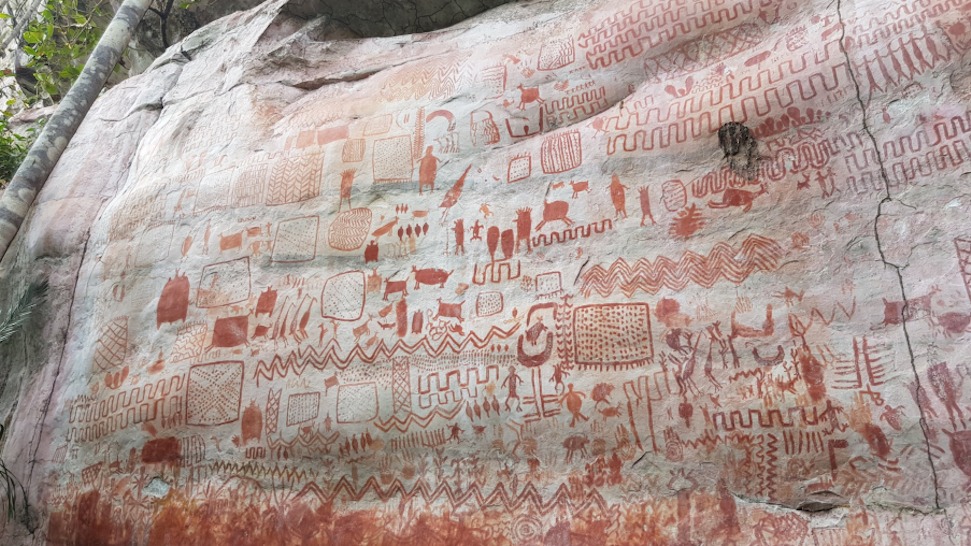Stunning rock art site reveals that humans settled the Colombian Amazon 13,000 years ago
The first humans arrived in the Colombian Amazon around 13,000 years ago.

The first humans to settle the Amazon Basin arrived around 13,000 years ago as part of a mass migration that quickly swept across the Americas, researchers have discovered.
After coming to what is now Serranía de la Lindosa, an archaeological site on the northern edge of the Colombian Amazon, these early Americans lived in rock shelters, fashioned stone tools, hunted and gathered and created massive displays of rock art, according to a new study, published in the March issue of the journal Quaternary Science Reviews.
While it was previously known that this area had been occupied beginning at least 12,600 years ago, as evidenced by the rock art, researchers were able to get a better understanding of how the area was utilized and any instances when it wasn’t occupied at all.
"The 'peopling' of South America represents one of the great migrations of human history — but their arrival into the Amazon biome has been little understood," Mark Robinson, associate professor of archaeology at the University of Exeter in the U.K., said in a statement. "For researchers working in the field, dense rainforest makes it challenging to identify potential fieldwork sites, and acidic, clay-based soils impair the preservation of organic remains. Our recent excavations, however, help to fill this gap, not only dating their arrival to much earlier than previously understood, but also providing novel insights into their lives and historical trajectories during the Holocene," the epoch following the last ice age that began 11,700 years ago.
For the new study, archaeologists collected soil samples from two rock shelters in the region. The team analyzed the stratigraphy, or layers, of the sediments and found different layers containing stone fragments, charcoal and "high levels of organic matter indicative of food preparation, consumption, and disposal," according to the statement.
Related: Ancient rock art in Argentinian cave may have transmitted information across 100 generations
The analysis showed there were periods when the shelters were completely abandoned — in some cases for more than a millennium at a time. Within the soil, researchers spotted 3,000-year-old ceramics, 2,500-year-old evidence of soil cultivation and 500-year-old traces of maize, according to the study. The analysis also revealed how early the locations were occupied.
Sign up for the Live Science daily newsletter now
Get the world’s most fascinating discoveries delivered straight to your inbox.
"The results firmly establish that the human occupation of Serranía La Lindosa began in the late Pleistocene, about 12,600 years ago, and continued until the 17th century," José Iriarte, professor of archaeology at the University of Exeter, said in the statement. "The exceptional number of rock shelters found in the region with evidence of human habitation suggest that this area was an attractive landscape for forager groups." It was there they could access a lush tropical forest, savannas and rivers to hunt and gather, he added.
In addition to the soil samples, archaeologists also unearthed animal bones, plant remains and ochre, which will be analyzed during future research.
"Activity patterns, artifact discard, and soil chemistry indicate that both rock shelters were used as domestic spaces through time, as well as sacred locations for the display of highly evocative art," Jo Osborn, a postdoctoral research associate at the University of Exeter, said in the statement. "All of the rock shelters exhibit ochre paintings from the earliest occupations, indicating that those pioneers were also recording and making sense of this new world they encountered."
Jennifer Nalewicki is former Live Science staff writer and Salt Lake City-based journalist whose work has been featured in The New York Times, Smithsonian Magazine, Scientific American, Popular Mechanics and more. She covers several science topics from planet Earth to paleontology and archaeology to health and culture. Prior to freelancing, Jennifer held an Editor role at Time Inc. Jennifer has a bachelor's degree in Journalism from The University of Texas at Austin.









